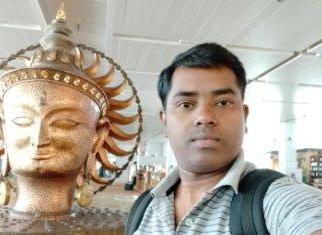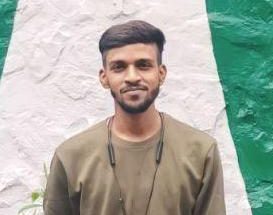Dr. Chandraiah Gopani, Mr.Anand Kumar, Mr. Pradip, Mrs. Annu Chouthmahal
There are contested views and understandings of the Indian freedom movement and nationalist thinking. A comprehensive study of the literature suggests that the Indian Freedom Movement was manifested in various ideological positions. Subalterns articulated a distinct nationalist thought aimed at challenging British and Brahmanical supremacy. In the discourse of Indian nationalism and its different manifestations,the freedom Movement plays a crucial role. History as a site of struggle very cunningly dodged off the contributions of the Dalits and their wretched experiences from the Indian Freedom movement. To fill this gap Govind Ballabh Pant Social Science Institute, Jhunsi, Prayagaraj, a constituent institute of Allahabad University has organised a series of academic events on “Dalit Contribution in Freedom Movement” under the aegis of Indian Council of Social Science Research (ICSSR), New Delhi. The convenor, Dr. Chandraiah Gopani, associate Professor, GBPSSI and the team seeking opportunity from the project entitled “Nationalist Vision of the Subalterns: A Study of Freedom Fighters’ Life and Struggle among Scheduled Castes (SC) in Telangana and Andhra Pradesh” convened the workshop aiming to brush up the polarised past of the ‘Indian Freedom Movement’ where the historians have adroitly subsided the historical contribution of the Dalits.
Academic Event-I: A lecture on ‘Dalit Women Freedom Fighters’
The very first series of the academic event entitled “Dalit Women Freedom Fighters” held on 30th January 2023, was hosted by Prof. Gopani. The chief guest and the key speaker was Mohandas Namishray who himself is a well-known writer and public intellectual. More than 200 participants attended the lecture. across the country have participated in the workshop.
The key speaker Mohandas Namishray, author of more than 80 books in Hindi and English covering range of various genres such as novel, short story, autobiography and critical treatise on Dalit Issues in India, spoke on “Dalit Women Freedom Fighters” where he began brushing up the question of triple slavery of the marginalised women (Dalit women); first the Dalit women were suffering in the hands of tyranny of the Brit-rule, second in the hands of local feudal system in which the Dalit women were treated as commodity and as a machine to appease the lust of the clean castes and the thirdly they were puppet of the patriarchal social order where their own men (beaten and broken by the upper castes) were churning them round the gyre of the domesticity, forced labour in the household of the clean castes, agricultural choirs and lastly these hapless women were forced to sacrificing their already extorted physique to their beaten and broken men at deadly hours in the night so that their looted ego can be repaired for the next day hegemonized routine. Thus, the speaker addressed these marginalised women as ‘slave of the slaves’ in a nutshell. Further in the course of his lecture, speaker Namishray questioned the polarised notion of the historians who have chronicled the Freedom Movement to be started with the mutiny of 1857 launched by a Brahmin Mangal Pandey while in actuality it was initiated by a Dalit Matadin Bhangi (1837-1857) who was working in the same barrack where Mangal Pandey was a soldier in the British Army in Meerut. It was Matadin who agitated Mangal Pandey by honing up his religious sentiments by informing him that the bullets they were using (with their mouth) were polished with cow fat.
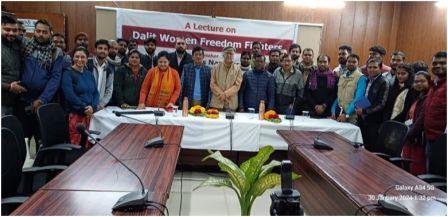
Post-session group photo
Namishray regrated that the historianshave adroitly dodged off the contribution of the Dalits and tribals in the Indian Freedom Movement even before and after the mutiny of 1857, for example, the efforts of Birsa Munda, Tilka Manjhi and the contribution of the Dalits and women like Rani Tulsi, Avantibai Lodhi, Uda Devi Pasi, Jhalkari Bai, Gangu Devi, Mahabiri Devi and the Santhal heroes of Santhal rebellion, Siddho, Kanho, Chand, Bahro and two sisters Phulo and Jhano, etc. Moving further, the speaker chronicled the story of Uda Devi in greater detail. He mentioned that Uda Devi, being an ordinary maid in the palace of Nawab Wazid Ali Shah in Sikardarbagh, Lucknow, was subsided by historians, though she played a crucial role in the Freedom Movement. During the seize of Lucknow, she sniped at a Peepal tree and bombarded the rain of ammunition at the British Army and after killing about 36 soldiers she was martyred for the sake of her land. Further in the course of his lecture, the speaker spoke about Avantibai Lodhi, Jhalkari Bai, Rani Gadinliu and other Dalit women freedom fighters. The speaker also mentioned some relevant literatures such as the literatures of Bihari Lal Harit, Mata Prasad, and others on the subject matter to enlighten the keen insights of the students and the research scholars. Finally, he concluded his lecture repenting on the passive attitude of the historians and the polarised notion of the sociologist and political theorist who dodged off the contributions of the Dalit community especially of the women.
Prof. Chandraiah Gopani who summarised the session and highlighted a few critical insights. Through his concluding remark, Prof. Gopani attempted to question the Brahmanical way of thinking and self-centred approach of historians in chronicling history. He brought up the invisible and often neglected contributions of the Dalit freedom fighters of the middle of the 18th century such as Puli Thevan and Kuyili and early part of the 19th century such as Sadalakshmi, Rajamani Devi,Dakshayani Velayudhan, Saradar Nagappa and his wife Amrawatamma who went to jail during her pregnancy while fighting against British. He also opined that there is an urgent need to critically engage with academic discourse and revisit the history from the bottom-up approach. The discussion was enriched by the active participation of the audience.
Academic Event-II: Brainstorming Workshop on ‘Dalits in Freedom Movement’
The second series of the event was based on the “Brainstorming Workshop on ‘Dalits in Freedom Movement” was held on 1st February 2024 in which Guru Prasad Madan(Public Intellectual), Prof. Harish S. Wankhede from JNU and Mohandas Namishray were the key speakers who spoke on different freedom fighters who sacrificed their blood in the Indian Freedom Movement.
The inaugural session was taken up by Prof. Harish S. Wankhede from JNU who joined the meeting online and spoke on Phule and Ambedkar’s Vision of the nation. Prof. Harish critically engaged with the contributions of Phule and Ambedkar towards an inclusive India where every individual can get equal opportunities and privileges. The speaker reiterated that it was Mahatma Phule who for the first time brought upthe legacy of ‘Bali-Rajya’ from the subaltern (Dalit) perspective and opened new horizons of inclusive social order. Further in the course of his lecture, Prof. Wankhede talked about Ambedkar’s critical engagement of Brahmanical historical discourse from the Bahujan perspective and emphasised (Ambedkar’s) legacy of ‘Prabudha Bharat’ and constitutional justice (extension of Phule’s vision) which primarily focus on equality, fraternity and justice. Towards the end of his lecture, Prof. Wankhede critically opened up Ambedkar’s vision of annihilating caste for inclusive nation-building. Further, he critiqued the duality of majoritarian Hindu nationalism and the limitation of secular Marxist perspective.
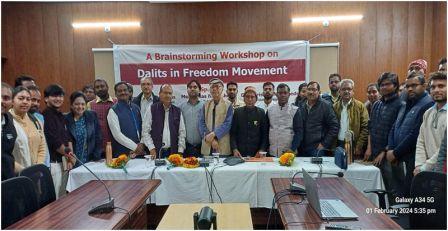
Group Photo after Brainstorming Workshop
Guru Prasad Madan taking the discussion of Indian Freedom Movement ahead, critically opened up new horizons of the Indian Freedom Movement with the history of Adi Hindu Movement in North India. Madan ji spoke on Swami Achhootanand and his historical contribution(s). In the first half of his lecture Maadan Ji dealt with sketching a brief biographical sketch of Swami Achhootanand in which he enriched the audience with rare pieces of information about Swamiji’s letter to Babasaheb Ambedkar in the context of the Round Table conferences. He described that being born in a Chamar community Swamii Ji had to undergo caste discriminations and wretched experiences of untouchability. Swami ji beinga propagator of the Adi Hindu philosophy had already envisioned an inclusive India where every individual, regardless of caste, class, creed and religion, can get equal social, economic and political opportunities. At the very tender age of 14, Swami came in contact with Arya Samaj and studied its core belief system and worked for the Arya Samaj for few years. However, he found that it (the Arya Samaj) was deeply rooted in the core belief of ‘Brahmanism’ and the Vedic tradition. After experiencing Brahamanical discrimination and graded inequality, Swami ji renounced the Arya Samaj and Published his first Poetic collection, Harihar Bhajan Mala and propounded that this Casteism and Varna system is based on the accident of birth and critiqued the caste system. Further in the course of his lecture, Madan ji opened up Swami Achhootanand’s vision of inclusive India which was spread across the country. A memorandum with 17 demands was presented by Swami Ji to the Prince of Walse. Swami Achhootanand launched his Adi-Hindu Movement in the year 1922 which preached the principles of egalitarianism and humanism. The movements like Adi-Dravida, Adi-Tamil, Adi-Kanaada, Adi-Andhra so on and so forth were influenced by Achhootanand’s Adi-Hindu movement. All these movements asserted an alternative nationalist thinking. Madan ji spoke that Swami ji was the first litterateur, the first editor, the first poet and the first novelist and established the first Dalit Press in North India. In the end, the speaker mentioned Swami’s inclusive approach, ‘manushyatwam hi Santantra dharmah’ inscribed at the top of his magazine as his motto.
Mohandas Namishray spoke on “Dalit contributionsin Freedom Movement:From Mangoo Ram to Chamar regiment”. Writer, Namishray centeredhis discussion around the Hindu religious notion and other elite class mentality towards the dispossessed communities.The concept of Martial race among Dalits and the Chamar regiment contributed enormously to the freedom movement.The Chamar regiment was a token of the bravery of the Chamar and other marginalized communities. During the Second World War, it was the Chamar regiment who had been assigned to the Eastern front (Rangoon, Imphal and Kohima) to fight against the German Nazi forcein which they proved their bravery tremendously. Namishray also described the uncanny incidents of Jaliyanwala Bagh (1919). He spoke that the majority of the deceased people were from the Dalit community. Further in the course ofhis lecture, Namishray spoke on Mangoo Ram and his contributions to the Freedom Movement where he mentioned that Mangoo Ram was, at that particular time, the international figure who was talking of inclusive society beyond the nation’s geographical boundaries. Writer, Namishray brought special emphasis on Mangoo Ram’s commitment towards the nation and contribution to the formation of Azad Hindu Fouj.
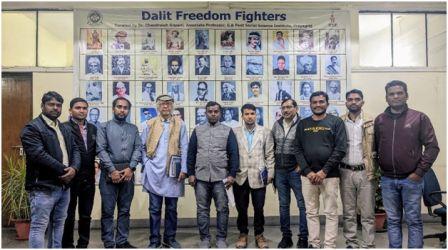
A glimpse of the Exhibition on ‘Dalit Freedom Fighters’
In the series, the ‘Photo Exhibition of Sixty Dalit Freedom Fighters’ has been the striking event. The primary aim of the exhibition was to highlight the invisible Dalit freedom fighters who sacrificed even the last drop of their blood for the Freedom Movement. The rare photos of sixty Dalit freedom fighters were curated by Prof. Gopani and his team.
Academic Event -III: A Book Discussion on ‘Dalit Freedom Fighters’
The third series of the events workshop, held on 2nd February 2024,was scheduled for a Book Discussion. The book Dalit Freedom Fighters, written by Mohandas Namishray, was critically introduced by Prof. Harish S. Wankhede who attended the programme online. While introducing the book, Dalit Freedom Movement, Prof. Wankhede spoke on Dalit struggle in the Indian Freedom Movement focusing on an inclusive approach where he reiterated ‘methodological problem’ in documenting history. He questioned the Brahmanical polarised notion of the historian. Because of this notion the Dalit literature that talks of the Dalit contribution to the Indian Freedom Movement. He mentioned that the literature appertaining to the Dalit community came into the picture but was in the yolk stage and could never gain the status of mainstream literature; it came only in the form of pamphlets, booklet, oral songs and powada (especially in the state of Maharashtra). In the course of his talk, Prof. Wankhede critically engaged with Namishray’s sociological engagement about the dispossessed people and their mobilization especially in the context of the Indian Freedom Movement.
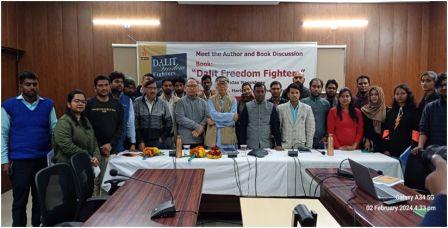
Group Photo after Book Discussion
The writer Namishray spoke about the agenda that he dealt with in his book. He mentioned that the majority of the book revolves around ‘The Role of Dalit in Chauri- Chaura, ‘Dalit in Jaliyawalabagh Massacre’, ‘Dalits in Quit India Movement’, ‘Dr. Ambedkar’s nationalist vision,’ etc. have been discussed in the book. The primary focus was on the Jaliyawala Massacre and the contribution of Udham Singh. He mentioned that it was Udham Singh who assimilated the rancorous memories of the Jaliyawala Bagh Massacre for about 21 years and then aimed to take revenge. To fulfill his desire of revenge he went to England and killed General O’ Dyer, the main suspect in the Jaliyawala Bagh Massacre in Long Ashton Hall in Somerset, England. Further Mohandas Namishray also drew a biographical sketch of General Dyer and his role in Jaliyawala Bagh Massacre. Later in the course of his lecture, Namishray criticized the media and historians’ polarised notions because of which they failed to document Udham Singh’s contribution with the vigor of the passion that Singh had for his motherland and in avenging the rancorous memories of the Jalianwala Bagh (1919). Towards the end of his talk, the author gave a very honoured tribute to the deceased souls of Jaliyawala Bagh Massacre who were primarily from Dalit community. He also discussed the last chapter of the book on Ambedkar and his speech at the first Round Table Conference. The speaker also briefly discussed about Prithvi Singh Azad and his contribution to the Indian Freedom Movement.
The discussion in the above three academic events aimed at exploring the Dalit nationalist vision. It is evident from the deliberations that the nationalist vision of the subalterns has been neglected and invisibilised both in the institutions and public domain using different mechanisms. This invisiblisation is just because those visions are in contestation with Brahmanical majoritarian nationalism and the limited understanding of the left-liberal approach. The discussion also emphasised on the need of historical and contemporary writings, and material for developing the anti-caste nationalist vision. We hope the new generation of scholars and activists will engage with the anti-caste nationalist praxis.
~~~
Dr. Chandraiah Gopani is an Associate Professor at G.B Pant Social Science Institute, University of Allahabad, Prayagraj, Uttar Pradesh. Anand Kumar (Research Assistant), Pradip (Research Assistant), and Annu Chouthmahal (Research Assistant) also worked in the ICSSR Research Project.

